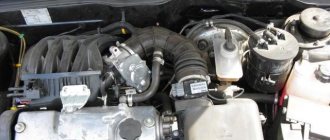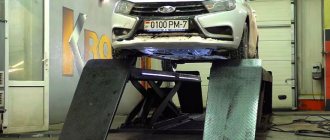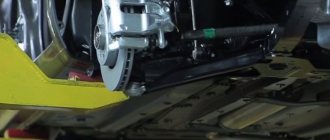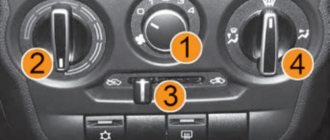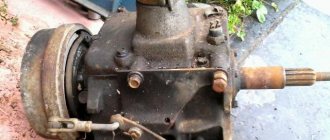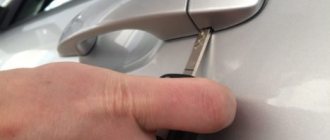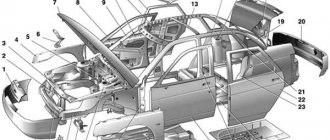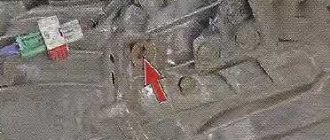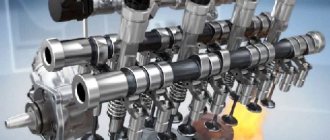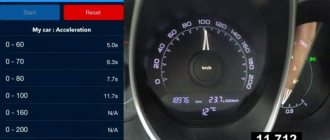Cars admin26.02.2020
First, let's see what the car looks like. Outwardly, it does not look like other VAZ models. If you saw it for the first time, you might think it was a foreign car. The front suspension has the advantage that when you need to change the struts, there is no need to adjust the wheel geometry. We installed other racks and went - simple maintenance and repair of Vesta. The ball joint is connected to the lever with rivets. When repairing, you will have to replace the lever completely, or cut off the rivets.
Engine compartment Vesta
Vesta’s engine compartment is occupied by a 1.6-liter engine equipped with 16 valves. The top is closed with a plastic cover on four stops. They allow you to quickly remove it for engine maintenance and repair. Under the cover we see that replacing the spark plugs on Vesta will not be difficult, since they are nearby.
The spark plugs have ignition coils equipped with connectors for connecting to the electrical circuit. The connectors are easy to remove. Then you need to unscrew the screws on the coils and inspect each spark plug.
Service book: what is it?
For a car, it plays the same role as a medical card for a person: it collects information about a person’s medical history (data about visits to the hospital, all “diseases,” medical examinations). Warranty information is recorded in the service book, starting from the sale of the car.
The first pages welcome the owner of Vesta, inform him of his rights in relation to the seller, and briefly describe the essence of the car warranty. Next, the page is devoted to confirming the pre-sale preparation of the car - that is, the car dealer signs the statement that the car is fully operational and ready for sale.
Several pages are reserved for warranty repairs - “tickets” for warranty repairs based on the owner’s claim are divided separately, indicating:
- mileage;
- number of the warranty service certificate;
- city and name of the company that carried out the repairs;
- list of replaced or repaired components and assemblies;
- company seal.
Remember that warranty repairs may be refused - do not leave the service without the appropriate mark. If it turns out that the malfunction falls under the warranty conditions, you will have confirmation that you have already applied, but received a refusal to claim.
Engine lubrication
The oil filler neck is located in front of the engine. To open it, you do not need to remove the plastic cover on the engine. This is convenient in terms of maintenance. But it is difficult to remove the oil filter. This requires removal of the crankcase protection. There is a drain hole for draining, but to remove the filter you still have to remove the protection.
This fact can be called an unpleasant moment under the hood of Vesta. After opening the hood, you can see that the front of the engine is dirty with dirt. The engine protection from below does not protect it well from road dirt. This is one of the disadvantages.
Self-service
Since the three-year warranty period had ended, we saw no reason to overpay the dealer for work if we had our own technical center in Tushino. And the consumables purchased at a regular spare parts store made the pockets lighter to a minimum. A canister of “synthetics” Lada Ultra 5W40 (1187 rubles), oil (193 rubles), air (255 rubles) and carbon cabin filters (334 rubles) - that’s the entire set required. Total - less than 2000 rubles for everything. An official TO-5 dealer would cost about 7,000 rubles.
Almost immediately after the purchase, Vesta was equipped with hood and trunk shock absorbers. The first are alive, the second gave up after one winter. And last winter they also began to creak disgustingly. I took it off and threw it away without any regrets.
Almost immediately after the purchase, Vesta was equipped with hood and trunk shock absorbers. The first are alive, the second gave up after one winter. And last winter they also began to creak disgustingly. I took it off and threw it away without any regrets.
Fuel system and injectors
Near the bottom corner of the plastic engine cover in the depth there is a fitting for measuring fuel pressure. It is closed with a cap, which must be unscrewed and a pressure gauge attached. Vesta may need to be serviced and repaired in terms of replacing filters and washing injectors. This is an inconvenient location of the fitting.
This car does not have an air flow sensor. Instead, there is an air temperature sensor and a pressure sensor. AvtoVAZ specialists solved the issue of floating engine speed at idle in this way.
Serial production of the compact Lada Vesta sedan, designed to replace the bestseller of the last decade, Lada Priora, was launched in 2015. British specialist Steve Mattin worked on the design of the new product, who managed to give the car a truly competitive appearance.
Controls
The Lada Vesta instruction manual gives a complete overview of the controls and instruments of the front panel. The document describes what this or that pointer on the on-board computer is intended for and what it means. This is necessary for control during vehicle operation.
The system warns the driver about all emergency situations and notifies when emergency mechanisms occur. It describes in detail how to operate the car in a particular case. How to tow a car in case of a breakdown and how to drive a Lada Vesta in difficult road conditions.
Content:
However, buyers of cars of this class pay attention not only to visual appeal, but also to practicality and functionality, which are largely determined by the dimensions of the vehicle. In this regard, Vesta is also at its best, since it surpasses in basic parameters not only domestic models, but also most competitors in its class.
Why do you need a service book?
A service book is a way to record all your actions; it is a kind of logbook. And this makes sense:
Reference material - technical inspection coupons in the title indicate the approximate mileage of the car at which you should contact a mechanic. Remember, these are not simple numbers, and every part in the car has a resource. The numbers written in the book are not a “joke”, but a recommendation from the designers and manufacturers of AvtoVAZ. Safety net - any refusal of warranty repairs may initiate legal proceedings on your part. If you are sure that there was a mistake in production, you should give the matter resonance - somewhere the same people as you are using cars from this batch. Your advantage when selling is that when the time comes to sell the car, potential buyers will have a lot of doubts and questions about the car. When you give the buyer a service book to read, with all the marks, it will be a signal to him that the seller took good care of the car and was not lazy to contact those regarding warranty issues. When you think about a guarantee, open the first pages of this book - you should rely on this information.
↑ Body characteristics and dimensions
In the manufacture of the body of the new Lada, exclusively high-strength steel alloys are used; it was decided to do without aluminum and other expensive materials, which are popular in the modern automotive industry. This approach made it possible to offer one of the most competitive prices in class B+ in comparison with foreign models, as well as to make the body as rigid and safe as possible, with a minimum of vibrations and extraneous noise.
When producing Vesta, AvtoVAZ uses new design technologies and the selective inclusion of high-strength special alloys in the body structure. Thanks to this, it is possible to avoid deviations in the geometry and dimensions of the body, prevent door skewing, and ensure good handling.
Initially, it was planned that the new model would replace the Priora in the VAZ line, although in all respects the new model is superior to the Tolyatti bestseller.
Main dimensions of Lada Vesta, meters:
- height – 1.497;
- body length – 4.41;
- wheelbase - 2.635;
- body width – 1.764;
- front track width – 1.5;
- rear track width - 1.51;
- turning radius – 5.2;
- aerodynamic drag coefficient – 0.82;
- ground clearance - 0.171.
AvtoVAZ specialists, when designing the overall dimensions of the Lada Vesta, were guided by its subsequent operation in domestic conditions, so the car is ideal for traveling on Russian roads. For example, thanks to the increased wheelbase, the car has excellent directional stability and controllability even on uneven road surfaces. A sufficiently high ground clearance makes it possible to overcome difficult sections of the road that many competitors cannot overcome.
Brakes: TRW brand, made in the Czech Republic, Poland, Italy, France, Turkey
In order for the Lada Vesta to stop properly, manufacturers from almost half of Europe had to work hard. In total, we counted five countries producing the braking system, including French SNR bearings pressed into the rear brake drums (integrated with the hub) of the German ATE brand, but of Italian production. When it is necessary to replace the bearing, it will be extremely difficult to remove it separately - most likely, you will have to change the entire assembly. Although the name of the SNR brand, which is premium by the standards of the world of auto components, inspires hope for durability.
So, the brake master cylinder and vacuum booster came from Poland, the front calipers and pads came from the Czech Republic. Some of the brake hoses turned out to be made in Turkey by Teklas. One of the features is that there is one brake system reservoir for two with a clutch drive.
The only question regarding the brakes arose when considering the front pads, on which there was a working mark of the cylinder - a quarter of the pressing surface extends beyond the pads. It is difficult to say whether this somehow affects the braking efficiency. While driving, we had no complaints about the braking system.
You will also have to tinker with the suspension elements during repairs. According to “foreign” patterns, the ball (produced by the BelMag Magnitogorsk plant) comes assembled with a lever. Moreover, replacing a component will require a lot of additional actions to free up space around it. By the way, according to servicemen, play of ball joints and knocking of stabilizer struts are the most frequent complaints from the first owners of Vesta.
Shock absorbers are one of the few Vesta components on which we did not see the “Aglitsky language”. The racks were produced at the Skopinsky Automotive Assembly Plant in the Ryazan region. By the way, in terms of the balance of suspension characteristics, we recognize Vesta as one of the best in the class.
We saw the only “Made in China” inscription on the windshield wiper motor from Bosch, with the logos of another automaker - the Chinese company Chery
↑ Comparison of dimensions with other cars in this class
When developing the Lada Vesta, the designers of the Togliatti automaker took into account the dimensions of the main competing models of other brands, and managed to surpass them in all key parameters.
| Model name | Body length, m | Wheelbase size, m | Body width, m | Ground clearance, m |
| Lada Vesta | 4,41 | 2,635 | 1,764 | 0,171 |
| Volkswagen Polo | 4,384 | 2,552 | 1,699 | 0,17 |
| Hyundai Solaris/Kia Rio | 4,37 | 2,57 | 1,7 | 0,16 |
| Renault Logan | 4,346 | 2,634 | 1,735 | 0,155 |
| Ford Fiesta | 4,32 | 2,489 | 1,722 | 0,167 |
In comparison with other B-class sedans presented on the domestic market and located in approximately the same price category as the VAZ model, Vesta is longer, taller, wider and has greater ground clearance. The increased dimensions of the body have a positive effect on its performance characteristics and convenience in everyday trips.
Optional equipment
For Vesta that is not equipped with a BC, you can buy an additional on-board computer, and the service center will connect, configure and control it in the same way as the standard one.
All described functions are supported, and some models have a function for displaying error codes. The price of an on-board computer for Lada Vesta can range from 4,500 to 9,000 rubles. The cost depends on the manufacturer and the controlled functions. When surveying Lada owners, positive feedback was received about BC. We can conclude: it is quite convenient and displays the readings necessary for the driver.
... not described in the manual, allow you to adjust the tone and volume of the turn signals and hazard warning lights. This menu is a service menu and, according to AvtoVAZ’s plans, should not be available to a wide range of users, since, unknowingly, the sound of the turn signal repeaters may be turned off, which will be mistaken for a malfunction.
| Lada Vesta sedan |
Hello, dear visitor, today we will talk about the hidden settings of the Lada Vesta on-board computer.
Hidden settings, not described in the manual, allow you to adjust the tone and volume of the turn signals and hazard warning lights.
To enter the hidden settings menu, press and hold simultaneously both on-board computer control buttons for about 5 seconds, located on the windshield wiper control lever (to the right of the steering wheel).
| Steering column switch (to the right of the steering column) |
Sound P1 will appear on the display of the bot computer.
| Setting up Sound P1 |
The parameter is changed using the on-board computer control buttons. Switching to the next parameter is done by pressing these two buttons simultaneously. After clicking, we will see the following settings.
Now let's look at what P and d mean in the settings of the Vesta on-board computer:
P1 – signal tone for turning on the direction indicators.
d1 – volume of the turn signal signal.
| Setting up Sound d1 |
P2 – signal tone for turning off the direction indicators.
| Setting up Sound P2 |
d2 – volume of the turn signal off signal.
| Setting up Sound d2 |
After making the settings, you must press and hold again for about 5 seconds until you go to the standard on-board computer screens. The entered settings will be automatically accepted.
It is recommended to turn on the hazard lights so you can hear the sound when setting up.
The last item in the hidden settings, called Pre Set, allows you to roll back to factory settings.
| Reset to factory settings - Pre Set item |
Thank you for being with us, leave your comments below, and if you still decide to pick out the upholstery, we advise you to purchase special plastic tabs.
Hidden settings of Lada Vesta video:
↑ Interior and luggage compartment dimensions
The new platform used to create the sedan made it possible to make the car not only larger, but also more comfortable. The Lada Vesta's interior dimensions are also very impressive: there is much more free space for both the driver and passengers than in previous Lada models.
Main interior dimensions, meters:
- the distance between the driver's seat cushion and the ceiling is 0.93-0.99;
- distance between the rear passenger seat cushion and the ceiling – 0.885;
- free space between the back of the front seat and the legs of the passenger sitting behind – 0.226;
- front seat cushion length – 0.45;
- rear seat cushion length – 0.48.
Taking into account the specifics of operating budget sedans in our country, which involves the periodic transportation of certain cargoes, the designers made sure that Vesta received a fairly spacious trunk.
Main dimensions of the cargo compartment, meters:
- height – 0.573;
- length - 0.962 (1.675, if the rear seat backs are folded);
- width max./min. – 1.424/1.033;
- loading height – 0.717.
The useful volume of the trunk is about 480 liters, and it can accommodate cargo weighing up to 400 kilograms.
Thus, AvtoVAZ specialists managed to design not only an attractive and reliable car, but also a very practical, convenient and functional one, maximally oriented towards the average Russian driver with an average income.
Lada Vesta is equipped with three types of engines with different technical characteristics, two of which have a volume of 1.6 liters, and the third has a volume of 1.8 liters. Models 21129 and 21179 were designed and assembled directly by AvtoVAZ, and the Nissan HR16 DE engine was created by foreign partners.
Each of the new units has its own positive and negative sides. The installation of an engine from a Japanese manufacturer (Nissan) on the Lada Vesta with a chain instead of a timing belt and a number of other differences became a sensation of sorts. A description of the features of the new engines follows in the text.
Controls
The Lada Vesta instruction manual gives a complete overview of the controls and instruments of the front panel. The document describes what this or that pointer on the on-board computer is intended for and what it means. This is necessary for control during vehicle operation.
The system warns the driver about all emergency situations and notifies when emergency mechanisms occur. It describes in detail how to operate the car in a particular case. How to tow a car in case of a breakdown and how to drive a Lada Vesta in difficult road conditions.
Analysis of the characteristics of the VAZ 21129
This engine is installed on the Lada Vesta and works with both a manual transmission and a robot. Has the following technical characteristics:
| Power | 106 hp |
| Volume (l) | 1.6 |
| Drive and timing type | Toothed belt, DOHC |
| Torque (Nm) | 148/4200 |
| Weight | 109.2 kg |
| Ignition | Electronic system controlled by microprocessor |
| Fuel type | Unleaded gasoline, 95 |
| Nutrition | Distributed injection |
| Speed up to 100 kilometers per hour | Happens in 12.8 s |
| Fuel consumption city (l) | 10,2 |
| Combined fuel consumption (l) | 7,5 |
| Fuel consumption highway (l) | 6,2 |
| Toxicity | Euro 5 |
| Resource | 200,000 kilometers |
Motor Features
The engine for Lada Vesta - VAZ 21129 is designed on the basis of its predecessor - VAZ 21127. It has a new modernized air supply system and good dynamics. This engine contains air temperature sensors, as well as absolute pressure sensors.
Such innovations make it possible to monitor the composition and quality of the working mixture with high accuracy, and also prevent the occurrence of floating speed in idle mode. This engine uses a special flap system that regulates the size of the intake manifold. Thanks to this system, the engine in the Lada Vesta operates optimally at any speed.
Various plastic parts
There is already such a diversity of companies and manufacturing countries that it makes no sense to single out anyone separately, so we’ll just list them.
The air filter and its housing turned out to be from the famous German brand Mann+Hummel, and of original production. The electric fuel pump module assembly (with an Arsan pump) is Russian. The radiator expansion tank hose is from Teklas, but not from Turkey, but from Bulgaria. Washer reservoir with Renault logos, Continental washer pump, made in the Czech Republic.
With the exception of the aforementioned Czech microclimate control unit, the plastic interior parts turned out to be Russian, in particular Izhevsk. Moreover, the quality of fastening (hence the country of production) of individual small parts could be determined by touch - they were either loose or fell out at the slightest touch.
There was also a Russian approach: the plastic frame of the gear lever (Italian-Russian company AE2) that was not “shrunken” was sharpened on the inside (apparently with a file) along the edge. The side plug of the front panel (on the side of the front right door) bounced off like a spring at the first attempt to snap it off (what voltage was it installed under?).
Taking into account some other flaws in the interior assembly in the form of naked screws and gaps, it is worth saying that the interior of the Lada Vesta is generally better assembled than can be expected from most modern Ladas, but it is felt that over time, part of it will traditionally “come to life”. By the way, at first glance we liked the interior assembly of the almost entirely imported Lada XRAY more.
Some time ago, the Avtostat agency published the full list of component suppliers - there are also a dozen foreign brands that we have not mentioned. Some of them, by the way, did not coincide with the real ones - in particular, the tires on our Vesta were Pirelli, not Continental.
Analysis of the characteristics of the VAZ 21179 engine
VAZ 21179 is a pioneer among 1.8 liter cars at AvtoVAZ and an innovation for Lada Vesta. The motor has gas distribution phases that can change, and it is collected on a conveyor using a selective method.
Externally, the engine is similar to standard Russian sixteen-valve models, but inside it is full of surprises. Lada Vesta, which has such a unit under the hood, is much more powerful than its counterparts with other engines and has good dynamics.
Motor specifications
| Power | 122 hp |
| Volume (l) | 1,8 |
| Drive and timing type | A timing belt tensioner from the German company INA is used. |
| Torque rating (Nm) | 170/3750 |
| Fuel type | AI 95 |
| Toxicity level relative to international standards | Euro 5 |
| Resource | 300,000 kilometers |
| Fuel consumption city (l) | 10 |
| Combined fuel consumption (l) | 8 |
| Fuel consumption highway (l) | 6-7 |
Having a Lada Vesta with a Nissan engine under the hood, you can be 100% confident in the reliability of your car. The internal combustion engine from Renault-Nissan is equipped with a reliable chain instead of a timing belt and can be filled with both 92 and 95 gasoline. Despite the sufficient number (114) horses under the hood, the Lada Vesta with such an engine consumes very little fuel and also has good dynamics. The new engine, which will soon be under the hood of the Lada Vesta, has an enlarged piston. The crank radius in the crankshaft was increased. The oil channels have been modernized, they have become more economical and practical. The timing mechanism system has been improved and many other changes have been made that have a positive effect on the power and dynamics of the engine.
Fuse box and its housing: Renault brand, made in Romania
The fuse box comes entirely from the Logan model, as evidenced by the Renault logos on the body and the Romanian manufacturer Capirom. True, AvtoVAZ reported that in the near future the company will change its supplier to a local one - from the Samara region.
We had no questions about the unit itself, but in the process of a scrupulous study by the electricians, a very interesting point emerged. Attention was drawn to two fuses that were not indicated either on the diagram or in the instructions. A study of the electrical circuit revealed that during a sudden voltage surge (for example, when lighting up a Vesta with the engine running), these fuses may burn out, resulting in the battery stopping charging. And what’s most insidious is that the driver of a discharged car will not know about it - no electrical “paths” to the dashboard (indicator lamps) could be found. Whether the reason will be revealed when connecting the standard diagnostic system in the absence of an error that pops up is also a question.
The controls also turned out to be imported - the steering rack is from the famous German brand ZF, but made in Malaysia. And the CV joints are provided by the British company GKN and made in Poland.
Characteristics of the Renault-Nissan H4M-HR16 DE engine
Characteristics of the Nissan engine
| Power | 114 hp |
| Volume (l) | 1.6 |
| Drive and timing type | Instead of a timing belt there is a chain |
| Torque (Nm) | 153/4400 |
| Fuel type | AI 92, AI 95 |
| Nutrition | Distributed injection |
| Fuel consumption city (l) | 8,2 |
| Combined fuel consumption (l) | 6,3 |
| Fuel consumption highway (l) | 5,4 |
| toxicity | Euro 5 |
| Resource | 250,000 kilometers |
Thanks to the chain, which is installed instead of a timing belt, the owner of a Lada Vesta will save money on replacing consumables. The chain is much stronger and more reliable and does not need to be replaced. Nissan designers have provided for the possibility of running this engine on methane. Therefore, owners of a Lada Vesta with a Nissan engine under the hood will have the opportunity to choose the type of fuel.
Maintenance records
In total, the Lada Vesta service book contains 12 maintenance coupons:
- Mileage 14,500 – 15,500 km, or after 1 year of operation;
- Mileage 29,500 – 30,500 km, or 1 year of operation after the previous maintenance;
- Mileage 44,500 – 45,500 km, or 1 year of operation after the previous maintenance;
- Mileage 59,500 – 60,500 km, possible after 1 year of operation after the previous maintenance;
- Mileage 74,500 – 75,500 km, or 1 year of operation after the previous maintenance;
- Mileage 89,500 – 90,500 km, possible after 1 year of operation after the previous maintenance;
- Mileage 104,500 – 105,500 km, or 1 year of operation after the previous maintenance;
- Mileage 199,500 – 120,500 km or 1 year of operation after the previous maintenance;
- Mileage 134,500 – 135,500 km, possible after 1 year of operation after the previous maintenance;
- Mileage 149,500 – 150,500 km or 1 year of operation after the previous maintenance;
- Mileage 164,500 – 165,500 km, or 1 year of operation after the previous maintenance;
- Mileage 179,500 – 180,500 km or 1 year of operation after the previous maintenance.
During each visit, the master will do:
- Diagnostic inspection work, during which the chassis, tires and wheels, steering play, power steering, headlights, battery, etc. will be checked at 18 points;
- Routine work (they consist of replacing technical fluids (brake, oil, etc.), replacing consumables (filters, timing belt, crankshaft, camshaft pulleys).

